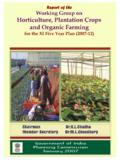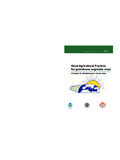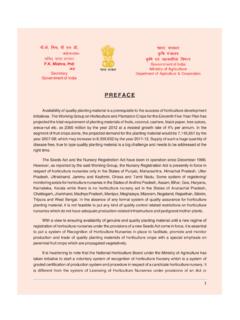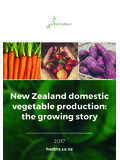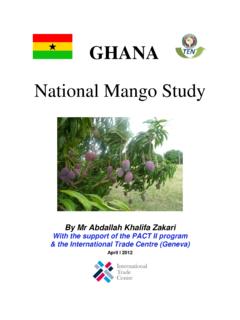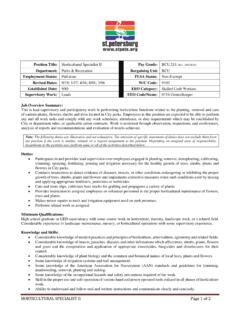Transcription of Peat in horticulture and conservation: the UK …
1 Mires and Peat, Volume 3 (2008), Article 08, , ISSN 1819-754X 2008 International Mire conservation Group and International Peat Society 1 Peat in horticulture and conservation : the UK response to a changing world Alexander1, Bragg2, R. Meade3, G. Padelopoulos4 and O. Watts5 1 Royal Horticultural Society, Woking, Surrey, UK; 2 Bulrush horticulture Ltd, Magherafelt, Co. Derry, UK; 3 Roger Meade Associates, Penrith, Cumbria, UK; 4B&Q plc, Eastleigh, Hampshire, UK; 5 Royal Society for the Protection of Birds, Sandy, Bedfordshire, UK. _____ SUMMARY Peat bogs are increasingly recognised as valuable habitats for wildlife and important stores of carbon. Yet the UK horticultural industry relies heavily on peat sourced from bogs in the UK and Republic of Ireland. Environmentalists, government and horticultural businesses in the UK now recognise the environmental consequences of using peat in horticulture , and the industry is turning increasingly to sustainable raw materials.
2 In this paper, the strengths and weaknesses of campaigning since 1990 to implement this change are analysed, with the intention of providing useful information for other countries facing similar challenges. The campaign encountered deeply-ingrained practices so that the shift in behaviour has been slow and, although now widespread, still meets resistance in some quarters. The UK Government introduced targets for peat replacement which have helped stimulate the industry to develop suitable alternatives. The major gardening retailers have included peat replacement targets in their environmental codes of practice, and these are being met through incremental peat dilution with alternative materials such as green compost and processed timber by-products. Legislative requirements for European biodiversity conservation have led the UK government to terminate peat extraction on significant areas of former commercial extraction.
3 The importance of peatlands for carbon sequestration and the major issue of climate change are increasingly focusing attention on peatland conservation , pointing towards the need for a more consistent approach to the use of peat across the European Community. KEY WORDS: growing media, peat reduction, alternative materials, environmental awareness. _____ INTRODUCTION Although the UK has significant peat resources, the Government is encouraging the horticultural industry to use an increasing proportion of alternatives, working towards the almost total replacement of peat. The reasons lie in the need to conserve habitats and species associated with peatlands and the increasingly recognised quest for environmental sustainability, while maintaining a competitive UK horticultural industry and concomitant employment. The shift was initiated and championed by voluntary nature conservation groups, conscious of the damage done to supposedly protected peatlands by commercial peat extraction, which was destroying rare habitats and cultural heritage, affecting water management, and potentially contributing to climate change.
4 Initially polarised views at the outset of the Peat Campaign, launched in 1990, gradually softened as awareness of the nature and complexity of the issues grew amongst the different interested parties. Peat reduction in the UK is now being led by a dynamic group representing all interests, who share the common goal of meeting challenging government targets for peat replacement. THE REASONS FOR CHANGE Historical use of peat The first commercially available standardised growing media in the UK were developed by Lawrence and Newell in the 1930s (Bunt 1988). These John Innes mixes were made from blends of loam (composted grass turves), peat and sand. However, quality loam was difficult to source and the heavy mixes made transport and handling expensive for a developing horticultural industry. Alexander et al. PEAT IN horticulture AND conservation : THE UK RESPONSE Mires and Peat, Volume 3 (2008), Article 08, , ISSN 1819-754X 2008 International Mire conservation Group and International Peat Society 2 Replacing the loam with peat in the 1970s solved both of these problems (Bragg 1998a).
5 As the popularity of gardening and garden centres grew, there was a huge increase in the use of growing media due to the increased production of containerised plants. The UK peat resource Lindsay & Immirzi (1996) identified million ha of peat soils (mostly >1 m deep) in Great Britain, of which 70,000 ha are lowland raised bogs, upon which the commercial interest for horticultural peat is focused. The UK Biodiversity Action Plan (1999) defines lowland raised bogs as those that develop primarily, but not exclusively, in lowland areas ( at the heads of estuaries, on river floodplains and in topographic depressions). In such locations, poor drainage may result in waterlogged anaerobic conditions leading to the accumulation of peat. Continued accrual of peat elevates the bog surface to form a gently curving dome which is raised above the regional groundwater level.
6 Raised bogs are ombrotrophic, which means that they depend entirely upon rainfall for their water and nutrients. Williams (2006) further defines active lowland raised bogs as those that continue to form peat, and degraded lowland raised bogs are those that are, at least temporarily, not forming peat but are still capable of natural regeneration. Of the original 70,000 ha lowland raised bog resource, only around 9,000 ha remain as either near natural (3,836 ha) or primary degraded bog (5,032 ha) and less than 4,000 ha currently have consent for extraction. The Northern Ireland Habitat Action Plan (2003) for lowland raised bog records 2,000 ha as intact, with 1,600 ha in near-natural state and 400 ha degraded, from an original resource of just over 25,000 ha. The Republic of Ireland, the UK s prime source of horticultural peat, has seen similar losses, from 308,742 ha to 25,189 ha retaining conservation value (Foss et al.)
7 2005). conservation status of peatlands The UK biodiversity conservation resource is protected by both national and European Community (EC) legislation. Important habitat sites are designated as Sites of Special Scientific Interest (SSSI) and (in Northern Ireland) Areas of Special Scientific Interest (ASSI), or as Natura 2000 sites (European Commission 1992) designated as Special Areas of conservation (SAC). Lindsay & Immirzi (1996) calculated that about 10% of the lowland raised bogs in Great Britain were designated as SSSI while in Northern Ireland 10% were designated as ASSI (Northern Ireland Habitat Action Plan 2003). The quality of lowland raised bogs in the UK is generally poor and the protected site list includes a high proportion of sites that are partly or totally damaged. Indeed, the EC Habitats Directive (European Commission 1992) recognises this situation across Europe, through the inclusion of the habitat category degraded raised bogs still capable of natural regeneration.
8 Lowland raised bog is the only habitat for which the Directive recognises a degraded type, the intention for this habitat being to identify and protect sites for restoration to quality habitat in addition to maintaining good quality sites. As with SSSI designation, some key UK peat extraction sites have been proposed as SACs, and in many cases accepted, because of the degraded raised bogs classification. This has led to termination of peat extraction and commencement of peatland restoration on several large bogs. Table 1 sums the areas of all confirmed active and degraded lowland raised bog SACs for each of the four countries of the UK. It shows that, although the proportion of degraded bog exceeds the guideline minimum (28%), active raised bog remains insufficient (45%) to meet the Natura 2000 30-year target. Table 1.
9 Total areas of UK active and degraded lowland raised bog designated as SAC under the EC Habitats Directive. Area*1 ha within SACs: active degraded England 3203 4361 Wales 926 264 Scotland 2260 1893 Northern Ireland 1434 431 UK SAC total (sum of above) 7823 6949 industry resource totals*2 17500 24500 separate % representation combined % representation*3 *1 SAC area summed from individual site areas available from JNCC (2008); *2 industry resource totals taken from William Sinclair horticulture s formal objection submission to the proposal to designate Bolton Fell Moss as a SAC; *3 the intention of Natura 2000 is for degraded bogs to become active bogs within 30 years.
10 Peat extraction has occurred on designated sites because most planning permissions for this activity were granted under Town & Country Planning legislation dating from the late 1940s, when the Alexander et al. PEAT IN horticulture AND conservation : THE UK RESPONSE Mires and Peat, Volume 3 (2008), Article 08, , ISSN 1819-754X 2008 International Mire conservation Group and International Peat Society 3biological value and rarity of peat bogs was not recognised. Where planning permission pre-dates nature conservation designation, the local authority is required to compensate the developer for any resulting restrictions to extraction rights, such as the requirement to restore damaged habitat. The compensation is beyond the financial means of local authorities, although it is in the national interest. Methods of extraction and the associated conflict with conservation All extraction methods involve clearance of the surface vegetation and site drainage.
